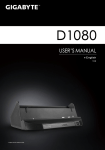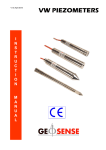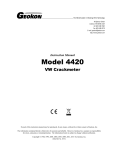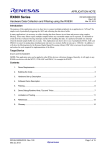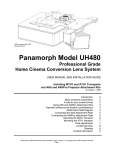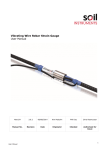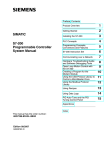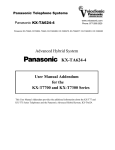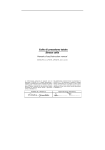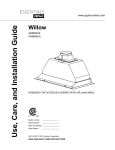Download VWCM-4000 Crack Meter Manual V1.0
Transcript
Version V1.0 VWCM-4000 CRACK METER I N S T R U C T I O N M A N U A L Version V1.0 2 Version V1.0 CONTENTS Page 1.0 INTRODUCTION 4 1.1 1.2 General description Theory of operation 4 5 2.0 CONFORMITY 6 3.0 MARKINGS 7 4.0 DELIVERY 8 4.1 4.2 4.3 4.4 Packaging Handling Inspection Storage 8 8 8 9 5.0 5.1 5.2 5.3 5.4 5.5 5.6 INSTALLATION Getting started Preliminary tests Setting distances Installation - using re-bar anchors Installation - using mechanical anchors Installation - using welded anchors 10 10 11 12 13 18 23 6.0 6.1 6.1.1 6.1.2 6.2 6.3 6.3.1 DATA HANDLING Taking readings Portable readouts Data loggers Data reduction Calibration certificate Temperature considerations Thermistor linearization 26 26 26 26 27 30 31 32 7.0 MAINTENANCE 33 8.0 TROUBLESHOOTING 33 9.0 SPECIFICATION 34 10.0 SPARE PARTS 36 11.0 RETURN OF GOODS 37 12.0 LIMITED WARRANTY 38 3 Version V1.0 1.0 INTRODUCTION This manual is intended for all users of VWCM-4000 Crack Meters manufactured by Geosense® and provides information on their installation, operation and maintenance. It is VITAL that personnel responsible for the installation and use of the VW Crack Meter READ and UNDERSTAND the manual, prior to working with the equipment. 1.1 General Description A Vibrating Wire Crack Meter can be installed singly or included in many types of monitoring regime and can be linked to various types of readout equipment. The primary uses for Geosense® VWCM-4000 Cracks Meters are :Measure movement of Joints and behaviour of Cracks in Structures. Measure Joint and Crack movement in Rock Faces With applications such as, but not limited to, the following :Bridges Dams Tunnels Buildings Rock Faces Mines Particular features of the Geosense® VWCM-4000 Cracks Meters are:Reliable long term performance. Rugged; suitable for demanding environments. High accuracy. Insensitive to long cable lengths. The Frequency signals generated by Vibrating Wire instruments are particularly suitable for the demanding environment of civil engineering applications. The signals are capable of long transmission distances without degradation. They are also somewhat tolerant of damp wiring conditions and resistant to interference from external electrical noise. The Geosense® range of VWCM-4000 Cracks Meters can be supplied in various configurations to suit varying installation environments and techniques. 4 Version V1.0 1.1 General Description contd Sensor cable Vibrating Wire Coil & Thermistor housing Housing Shaft Top Rose joint (fixed) Bottom Rose joint (adjustable) 1.2 Theory of Operation The Geosense® VWCM-4000 Crack Meter is an stainless steel instrument that contains a VW transducer that is connected to a Calibrated Spring which is in turn connected to an extending shaft. The ends of the instrument are connected to either side of a crack or joint so that, as structural movement occurs, the shaft is moved within the housing. The shaft movement changes the tensions the spring which, in turn, changes the tension in the vibrating wire. When interrogated, the vibrating wire in the transducer measures its tension which can be converted to a linear displacement measurement in engineering units, commonly millimetres. The internal parts of all Geosense® VWCM-4000 Crack Meters are identical, only the ’Spring Rate’ of the spring and the length changes. Within the Vibrating Wire transducer coil housing, two coils are located close to the axis of the wire. When a voltage, or swept frequency excitation is briefly applied to the coils, a magnetic field is created momentarily, causing the wire to oscillate at its’ resonant frequency. The wire continues to oscillate for a short time through the ‘field’ of the permanent magnet, thus generating an alternating current (sinusoidal) output. The frequency of this current output is detected and processed by a vibrating wire readout unit or by a data logger equipped with a vibrating wire interface. Readings can be converted, by calculation, into ‘Engineering’ units. 5 Version V1.0 2.0 CONFORMITY Geosense Limited Nova House Rougham Industrial Estate Rougham, Bury St Edmunds Email: [email protected] Declaration of Conformity We Geosense Ltd at above address declare under our sole responsibility that the Geosense products detailed below to which this declaration relates complies with protection requirements of the following harmonized EU Directives, Low Voltage Directive 73/23/EEC (as amended by 93/68/EEC) The Electromagnetic Compatibility Directive 2004/108/EC The Construction Products Directive 89/106/EEC Equipment description Make/Brand Model Numbers VW Crack Meter Geosense VWCM-4000 Crack Meter Range Compliance has been assessed with reference to the following harmonised standard: EN 61326-1:2006 Electrical equipment for measurement, control and laboratory use. EMC requirements. General requirements. A technical file for this equipment is retained at the above address. Martin Clegg Director June 2014 6 Version V1.0 3.0 MARKINGS Geosense VW Crack Meter are labelled with the following information:Manufacturers name & contact details Product name Product Type Operating Range Serial number Electrical Input & Output details CE mark 7 Version V1.0 4.0 DELIVERY This section should be read by all users of VWCM-4000 Crack Meters manufactured by Geosense® . 4.1 Packaging VWCM-4000 Crack Meters are packed for transportation to site. Packaging is suitably robust to allow normal handling by transportation companies. Inappropriate handling techniques may cause damage to the packaging and the enclosed equipment. The packaging should be carefully inspected upon delivery and any damage MUST be reported, as soon as possible, to both the transportation company and Geosense. 4.2 Handling Whilst they are a robust devices, VWCM-4000 Crack Meters are precision measuring instruments. They and their associated equipment should always be handled with care during transportation, storage and installation. Once a shipment has been inspected, it is recommended that VWCM-4000 Crack Meters remain in their original packaging for storage or further transportation. Cable should also be handled with care. Do not allow it to be damaged by sharp edges and do not exert force on the cable as this my damage the internal conductors and could render an installation useless. 4.3 Inspection It is important to check all the equipment in the shipment as soon as possible after taking delivery and well before installation is to be carried out. Check that all the components detailed on the documents are included in the shipment. Check that the equipment has not been physically damaged. ALL Geosense® VWCM-4000 Crack Meters carry a unique identification serial number and are supplied with individual calibration sheets. Calibration Sheets contain VITAL information about the VW Crack Meter. They MUST be stored in a safe place. It is suggested that only copies should be taken to site. 8 Version V1.0 4.4 Storage All equipment should be stored in an environment that is protected from direct sunlight. It is recommended that cables be stored in a dry environment to prevent moisture migrating along inside them in the event of prolonged submersion of exposed conductors. Storage areas should be free from rodents as they have been known to damage cables. No other special requirements are needed for medium or long-term storage although temperature limits should be considered when storing or transporting associated components, such as readout equipment. 9 Version V1.0 5.0 INSTALLATION This section of the manual is intended for all users of VWCM-4000 Crack Meters manufactured by Geosense® and is intended to provide guidance with respect to their installation. It must be remembered that no two installations will be the same and it is inevitable that some ‘fine tuning’ of the following procedures will be required to suit specific site conditions. It is VITAL that personnel responsible for the installation and use of the VWCM-4000 Crack Meters READ and UNDERSTAND the manual, prior to working with the equipment. ********** As stated before, it is vital to check all the equipment in the shipment soon after taking delivery and in good time before installation is to be carried out. Check that all components that are detailed on the shipping documents are included. 5.1 Getting started - Preparation for Installation Prior to installation of a VWCM-4000 Crack Meters it is essential to establish and confirm details of the installation to be carried out. Some of the main considerations are listed below :1. Intended location and subsequent Protection 2. Expected Movement of the Crack or Joint (see setting range) 3. Anchoring Method 4. Cable routing and marking The end of the cables connected to VWCM-4000 Crack Meters is marked with the unique serial number of the sensor to which it is attached. All instrument cables should be marked with unique identification (e.g. colour codes). Markings should be repeated at regular intervals along the cable where multiple cables are to be grouped together, so that in the event of cable damage, there may be a chance that the identification could be exposed and the cables re-joined correctly. Multiple cable marks are particularly important close to the end of the cable. The spacing of markings can vary according to specific site requirements but a guide of 5m to 10m separation is commonly applied (marking materials available on request from Geosense). Cable routing must be carefully considered so as to ensure that it is not vulnerable from intentional or accidental damage. Vibrating Wire signals can be affected by electrical interference (EMI), so cable routing should AVOID close proximity to possible sources. 10 Version V1.0 5.1 Getting started - Preparation for Installation contd... Tools Obtain any tools necessary to carry out the installation. The following is a brief list of tools typically used during the installation of VWCM-4000 Crack Meters. • • • • • • • • • • • Wire cutters and strippers Vibrating Wire Readout unit for setting the Crack Meter Cable Marking system / equipment ( e.g. coloured PVC Tapes ) Marker Pen Hammer Drill (mains for battery powered) Drill Bit suitable for the materials into which the fixings will be fixed Power Supply for the drill (if required) Clean Cloth Suitable resin bonding material 4mm & 5mm ‘Allen’ (hexagonal) keys. Adjustable spanner 5.2 Preliminary tests Before installing the VWCM-4000 Crack Meter, it should be checked for proper operation. Using a manual readout, such as a VW2106 (see readout manual), select the B sweep range (1200 3550 Hz) and connect the signal wires as shown on the right. Gently pull the shaft out to its, mechanical, full extension stop. DO NOT TWIST THE ROD. The readout should display an increasing reading up to 6700-7200 Digits. This value should be checked against the Full Range reading on the individual calibration certificate. Gently allow the shaft to return into the housing making sure that the pins on the shaft are aligned into the slot on the housing. Check the operation of the thermistor by holding the red coil housing in your hand; the temperature reading on the readout should slowly increase. *NB If the readout display is in ‘Period’ units a calculation must be performed to convert from Hertz2/1000 ( Linear Digits ) units, since the calibration sheet is presented in Hertz2/1000 units. The Geosense Readout model VW200 displays the readings in ‘Period’. The RST readout / logger unit Model Number VW2106 displays the readings in Linear Digits. See Section 6 of this manual for more information about units and conversion routines. DO NOT TWIST THE SHAFT OF THE CRACK METER 11 Version V1.0 5.3 Anchor spacing distance The positioning of the fixing anchors (spacing distance) will depend on the range of the crack meter and whether extension or compression is to be monitored. If this is unknown gauges are typically set to mid-range. The Table below shows the suggested anchor spacing distances for various operating ranges and measurement configurations. If, for example, a crack meter is to be used to measure only opening of a crack, we suggest that a 10% allowance for closing (compression) is built into the spacing so that un-expected closing does not damage the gauge. A similar principle is recommended for the spacing of anchors for crack closing applications. These are only recommendations and the user should decide what positions the anchors are required to be set. A portable readout and the individual calibration certificate must be used in conjunction with the table below to determine/confirm the required anchor spacing. 50% of range (mm) MONITOR COMPRESSION 90% of range (mm) MONITOR EXTENSION 10% of range (mm) 5 228.3 230.5 226.0 12.5 246.6 252.3 241.0 25 300.3 311.5 289.0 50 343.5 366.0 321.0 75 447.8 481.5 414.0 100 492.0 537.0 447.0 150 640.5 708.0 573.0 200 795.0 885.0 705.0 300 1097.0 1232.0 962.0 500 1704.0 1929.0 1479.0 RANGE (mm) MID RANGE All of the above are approximate dimensions and the setting, ‘centre to centre’ distance on the crack meter may need to be adjusted using the Rose joint on the end of the shaft. 12 Version V1.0 5.4 Installation - using Re-bar anchors INSTALLATION TEMPLATE It is recommended to make and use a ‘site specific’ spacing template for the following reasons:• Maintains a consistent setting distance between the anchors • Makes marking of drill holes easier • Helps keep anchors in place during the curing of the fixing resin Typical materials that can be used to make the template are wood, steel or plastic. Obviously if the material is soft ( wood / plastic ) it will wear more with use. 1. Cut a suitable piece of bar for use as a template. Carefully mark the centres of the holes that correspond to the position of the fixing holes. Drill one 5mm and one 6mm hole in the template. 2. Clear the intended location of debris or dust. 3. Using the template, mark the hole centres to be drilled. Using a suitable masonry drill bit, drill a pilot hole in the locations marked. 4. Select a suitable masonry drill bit for the groutable anchors that are to be used. 12mm rebar use 18mm drill bit 16mm rebar use 20mm drill bit 5. Measure the required depth to be drilled and set a stop on drill so that hole is drilled to the required depth. 13 Version V1.0 5.4 Installation - using Re-bar anchors contd... 6. Drill both holes to the required depth. BE SURE NO ELECTRICAL CABLES OR OTHER SERVICES ARE DIRECTLY BELOW SURFACE TO BE DRILLED 7. Cleaning out the drill holes before inserting bonding resin is essential . A small brush is a good tool for cleaning out the loose debris and the bicycle pump is good for blowing out the dust so that the resin can adhere well to the inner walls of the hole. 8. To install the groutable anchors will require a gauge template plus suitable fixing resin* and applicator gun ( if necessary ). 14 Version V1.0 5.4 Installation - using Re-bar anchors contd... 9. Attach the anchors to the template with the M5 and M6 screws supplied, as shown. SELECT A NON-SHRINKING RIGID RESIN SUITABLE FOR THE MATERIAL INTO WHICH ANCHORS ARE BEING PLACED 10. Thoroughly mix an adequate amount of resin and fill the anchor holes. Where a resin cartridge is being used, insert the cartridge nozzle into the base of the holes and fill from the base upwards. 11. Insert the groutable anchors to the required depth, rotating them to ensure a good bond. Leave the resin to cure for the time stated in the product manufacturer’s instructions. 15 Version V1.0 5.4 Installation - using Re-bar anchors contd... 12. Once the resin has hardened remove the securing screws. 13. Fix the M6 bolt through the Rose joint on the transducer end of the crack meter and into the rebar anchor. 14. Fit the M5 bolt through the Rose joint on the shaft end of the gauge and carefully extend the shaft. Fix the screw into the anchor but do not tighten it. A reading of the gauge should be taken to ascertain correct setting before the bolts are fully tightened. 15. Check the reading on the readout to ensure that it is at approximately the value that corresponds to the extension required. This should be checked against the individual calibration sheet for the Crack meter being installed. 16 Version V1.0 5.4 Installation - using Re-bar anchors contd... 16. If the reading/setting distance is not in the correct range then adjustments can be made to the threaded Rose joint on the shaft of the crack meter. To adjust, undo M5 bolt and carefully remove Rose joint from the anchor. Ensure that the Rose joint locking nut is loose and turn the Rose joint clockwise to lower the crack meter readings and anticlockwise to raise the readings. DO NOT ROTATE THE SHAFT 17. When the reading is correct remove the fixing and carefully allow the crack meter to close, ensuring the alignment pins engage with the slots on the housing tube. Tighten the locking nut to ensure that the rose joint is tight. 18. Re-fix the crack meter to the anchor and tighten the screw using the Allen key. The crack meter is now installed. Its readout cable can be routed to a convenient location for termination or to a data logger location. It is strongly recommended that the crack meter is fitted with a lined protective cover to reduce the risk of damage and reduce the effects of temperature changes. ONCE INSTALLED AND THE CRACK METER’S TEMPERATURE HAS STABILISED, IT IS IMPORTANT TO ESTABLISH INITIAL READINGS. ALL SUBSEQUENT READINGS WILL BE REFERENCED TO THESE INITIAL READINGS 17 Version V1.0 5.5 Installation - using mechanical type anchors INSTALLATION TEMPLATE It is recommended to make and use a ‘site specific’ spacing template for the following reasons:• Maintains a consistent setting distance between the anchors • Makes marking of drill holes easier Typical materials that can be used to make the template are wood, steel or plastic. Obviously if the material is soft ( wood / plastic ) it will wear more with use. 1. First gather all the components and tools together. For this type of installation, this will include: Template Hammer Drill Suitable Drill Bit(s) 10 and 13mm spanners Hammer Adjustable spanner 4mm and 5mm Allen Keys Anchors Mounting blocks Gauge with Rose joint ends 2. Clear the installation area and mark the position of the fixings using the template. 3. Set the depth gauge on the drill to the required depth. 18 Version V1.0 5.5 Installation - using mechanical type anchors - cont... 4. Drill the holes for the anchors BE SURE NO ELECTRICAL CABLES OR OTHER SERVICES ARE DIRECTLY BELOW SURFACE TO BE DRILLED 5. Clean out the drill hole to ensure it is free from dust. A bicycle pump is useful here. 6. Install the anchors - as anchor types differ, the fixing of the anchors will vary. 19 Version V1.0 5.5 Installation - using mechanical type anchors - cont... 7. Tighten any securing nuts / bolts to ensure that the fixing does not move 8. Fit both the mounting blocks to the anchors. Remember that one end has a larger and one a smaller threaded crack meter mounting. Use the second nut on the fixing to ‘lock’ the mounting block onto the anchor. 9. Ensure that the larger Rose joint end is firmly attached to the Crack meter by checking that it fully tightened up to its locking nut. 20 Version V1.0 5.5 Installation - using mechanical type anchors - cont... 10. Fit the larger end of the crack meter ( sensor end ) to its mounting using the M6 bolt. 11. Tighten the bolt using the 5mm Allen key ( use a spanner on the locking nut as a tightening reaction ) 12. Check that smaller Rose joint is screwed into the other end of the Crack meter. ( it is best to screw it fully into Crack meter and then unscrew it by 4 turns, leaving the locking nut loose, at this stage. Carefully draw the end of the transducer out and fit it the mounting block, using the M5 screw. 13. Check the reading on the readout to ensure that it is at approximately the value that corresponds to the extension required. This should be checked against the individual calibration sheet for the Crack meter being installed. 21 Version V1.0 5.5 Installation - using mechanical type anchors - cont... 14. If the reading/setting distance is not in the correct range then adjustments can be made to the threaded Rose joint on the shaft of the crack meter. To adjust, undo M5 bolt and carefully remove Rose joint from the anchor. Ensure that the Rose joint locking nut is loose and turn the Rose joint clockwise to lower the crack meter readings and anticlockwise to raise the readings. DO NOT ROTATE THE SHAFT 15. When the reading is correct remove the fixing and carefully allow the gauge to close, ensuring the alignment pins engage with the slots on the housing tube. Tighten the locking nut to ensure that the rose joint is tight. 16. Re-fix the gauge to the anchor and tighten the screw using the Allen key and a spanner on the anchor locking nut. The crack meter is now installed. Its readout cable can be routed to a convenient location for termination or to a data logger location. It is strongly recommended that the crack meter is fitted with a lined protective cover to reduce the risk of damage and reduce the effects of temperature changes. ONCE INSTALLED AND THE CRACK METER’S TEMPERATURE HAS STABILISED, IT IS IMPORTANT TO ESTABLISH INITIAL READINGS. ALL SUBSEQUENT READINGS WILL BE REFERENCED TO THESE INITIAL READINGS 22 Version V1.0 5.6 Installation - using Welded anchors INSTALLATION TEMPLATE It is recommended to make and use a ‘site specific’ spacing template for the following reasons:• Makes marking of mounting positions easier • Can be used to support the anchor blocks during welding Typical materials that can be used to make the template are wood, steel or plastic. Obviously if the material is soft ( wood / plastic ) it will wear / melt with use. 1. First gather all the components and tools together. For this type of installation, this will include: Template 10 mm spanner Adjustable spanner 4mm and 5mm Allen Keys Mounting blocks Gauge with Rose joint ends Welding Equipment 2. Clear the installation area and mark the position of the fixings using the template. 3. Weld the mounting blocks in the required position. 23 Version V1.0 5.6 Installation - using Welded anchors - cont…. 4. Ensure that the larger Rose Joint end is firmly attached to the Crack meter by checking that it fully tightened to its locking nut. 5. Fit the larger end of the crack meter ( sensor end ) to its mounting, using the M6 bolt through the Rose joint, and tighten the Allen screw. 6. Slide the M5 bolt through the mounting hole on the Rose joint on the shaft end of the crack meter. Carefully draw the shaft out and fix it to the other anchor, but do not tighten reading of the gauge should be taken to ascertain correct setting before the bolts are fully tightened. 7. Check the reading on the readout to ensure that it is at approximately the value that corresponds to the extension required. This should be checked against the individual calibration sheet for the Crack meter being installed. 24 Version V1.0 5.6 Installation - using Welded anchors - cont…. 8. If the reading/setting distance is not in the correct range then adjustments can be made to the threaded Rose joint on the shaft of the crack meter. To adjust, undo M5 bolt and carefully remove Rose joint from the anchor. Ensure that the Rose joint locking nut is loose and turn the Rose joint clockwise to lower the crack meter readings and anticlockwise to raise the readings. DO NOT ROTATE THE SHAFT 9. When the reading is correct remove the fixing and carefully allow the gauge to close, ensuring the alignment pins engage with the slots on the housing tube. Tighten the locking nut to ensure that the rose joint is tight. 10. Re-fix the gauge to the anchor and tighten the screw using the Allen key and a spanner on the anchor locking nut. The crack meter is now installed. Its readout cable can be routed to a convenient location for termination or to a data logger location. It is strongly recommended that the crack meter is fitted with a lined protective cover to reduce the risk of damage and reduce the effects of temperature changes. ONCE INSTALLED AND IT’S TEMPERATURE STABILISED, IT IS IMPORTANT TO ESTABLISH INITIAL READINGS. ALL SUBSEQUENT READINGS WILL BE REFERENCED TO THESE INITIAL READINGS 25 Version V1.0 6.0 DATA HANDLING The function of an instrument is to provide useful and reliable data. Accurate recording and handling of the data is essential if it is to be of any value. 6.1 Taking readings 6.1.1 Portable Readouts Geosense® offer a range of readout and data logging options. Specific operation manuals are supplied with each readout device. Below is a brief, step-by-step procedure for use with the VW2106 portable readout. 1. Connect signal cable from the sensor to the readout following the wiring colour code. Conductor colours may vary depending upon the extension cable used. Commonly these are: RED BLACK GREEN WHITE = = = = VW + VW Temp Temp 2. Switch on the unit and, where necessary, select range B 3. The readout displays the Vibrating Wire reading ( in Hz2/1000 - Linear Digits ) and a temperature reading in degrees C. Whilst it is not critical that the polarity be observed for most Vibrating Wire instruments, a better signal may be obtained if the correct polarity is adopted. Since the temperature sensor is a Thermistor, its connection polarity is not important. 6.1.2 Data Loggers A number of data loggers are available to automatically excite, interrogate and record the reading from Vibrating Wire instruments. These include devices manufactured and supplied by Geosense in both single and multi-channel configurations, as well as equipment manufactured by other suppliers. Geosense configures and supply's equipment manufactured by both Campbell Scientific Ltd and DataTaker Ltd. These are the most commonly adopted third party manufacturers of data loggers that can be used with Vibrating Wire Instruments. Specific configuration and programming advice can be obtained from Geosense and/ or the manufacturers documentation. 26 Version V1.0 6.2 Data Reduction Overview Readings from a crack meter are in a form that is a function of frequency, rather than in units of distance. Commonly the units would be either Frequency - Hertz (Hz), Linear - Hz2/1000 or Hz2/1000000 or Period - Time - (Seconds x10-2 or x10-7). To convert the readings to units of distance, calibration factors must be applied to the recorded values. For most Vibrating Wire sensors, these factors are unique and are detailed on the sensor calibration sheet. A unique calibration sheet is supplied with each Geosense VW crack Meter. An example of the calibration sheet is shown on page 39. If the readout display is in Period units ( e.g. 0.03612 or 3612 - depending upon the readout used ) the first step to producing an engineering value is to convert the readings to Linear Digits ( Hz2/1000 ) . Two examples of this calculation can be seen below. The first (1) where the readout includes a decimal point and displays the Period in Seconds–2 and the second (2) where the readout displays the Period in Seconds-7 (1) Readout Display Linear Digits (Hz2/1000) = = = 0.03612 ( 1 / 0.03612 –2 ) 2 / 1000 7664.8 (2) Readout Display Linear Digits (Hz2/1000) = = = 3612 ( 1 / 3612 –7 ) 2 / 1000 7664.8 If the readout displays ‘Frequency’ values, ( e.g. 2768.5 Hz ) only a simple calculation is required to convert the readings to ‘Linear Digits’. Linear Digits (Hz2/1000) = = ( 2768.5 ) 2 / 1000 7664.6 Certain data loggers store their Vibrating Wire data in Linear Digits but further divided by 1000. In this case the data would have to be multiplied by 1000 to maintain the standard Linear Digits (Hz2/1000) format for the standard calculations. There are many ways to achieve the conversion from recorded data to useful engineering values. The following are included as a guide only and as a basis for alternative approaches. Linear Calculation This is the most straight forward calculation to convert ‘raw’ data to engineering units. It requires that the readings are in Linear Digits (Hz2/1000) and it can be easily carried out using a simple calculator. Where this is not the case, the readings must 27 Version V1.0 be converted to Linear Digits prior to computation. For most applications this equation is perfectly adequate and is carried out as follows: Displacement (mm) = Linear Factor (K for mm) x (Current Reading - Initial Reading) Polynomial Calculation In some instances, this calculation can be slightly more precise as it accommodates some slight deviation of the data from a straight line calibration. However, in its standard form, it does not easily accommodate site recorded base readings or environmental changes that may affect the zero or initial value (such as altitude). Displacement ( mm ) = [ Factor A for mm x (Reading)2 ] + [ Factor B for mm x Reading]+ Factor C for mm The instrument calibration sheet similar to the example on page 31 of this manual includes the following information: Model Serial Works ID Cable m Readout No. R/O Cal Date Cal Date Master Temp oC Batch Range mm Ap. Displacement Hz2 * 10-3 Ind. Displacement Lin. Error % FSO Poly. Error % FSO Deviation Hysteresis Calibration Factors This refers to the Geosense model number. This is a unique sensor identification number that can be found on the body of the crack meter and, for long cables, at the end of the cable. Unique works code Length of cable fitted Serial Number of the readout used to display the crack meter output The date on which the Readout was calibrated to a traceable standard Date the calibration of the crack meter was performed Serial number of the Master Transducer used for the calibration Temperature at which the unit was calibrated Works batch number Operating range of the crack meter Displacement applied to the transducer as part of the calibration cycle in mm Readings from the crack meter as movement is applied and reduced, in steps. The average is calculated. Calculation of the displacement using the calculated Linear and Polynomial equations. Non Linearity expressed as a percentage of the crack meters Full Scale. Non Linearity expressed as a percentage of the crack meters Full Scale. Non Linearity expressed in Digits (Hz2/1000) Difference between increasing and decreasing readings as a percentage of the crack meters Full Scale. ‘Linear’ and ‘Polynomial’ factors are provided for a selection of 28 Version V1.0 (Continued from page 28) Engineering units ( other units can be calculated directly from the mm values ). Examples of calculated values are detailed below. The following are examples of data reduction calculations and are based upon the crack meter to which the attached example calibration sheet refers. The results are displayed as ‘change in distance’ in millimetres A. An example of the calculation from Period units (Seconds –7) to mm using a Linear equation is given below:Site Initial Reading (period units) Initial Converted to Linear Digits Calibration Factor for mm (K) = 5142 = 3782 = 0.012218561 Current Reading (period units) Current Converted to Linear Digits = 4282 = 5454.8 Equation Displacement in mm Displacement in mm Displacement in mm B. = K x ( Current Reading - Initial Reading ) = 0.012218561x ( 5454.8 - 3782.0 ) = 20.44 mm An example of the calculation from Linear Digits ( Hz2/1000) to mm using a Polynomial equation is given below:Calibration Factors for mm A B C Current Reading in Linear Digits = 3.9746 -8 = 0.011820338 = - 35.375 = 5454.8 Equation Displacement in mm = [ A x ( Reading )2 ] + [ B x Reading ] + C = [ 3.9746 -8 x (5454.8)2] + [ 0.011820338 x 5454.8] - 35.375 = 1.183 + 64.477 - 35.375 = 30.29 mm ‘Linear’ calculations require the establishment of an Initial reading on site after the crack meter has been installed and its temperature stabilised. This is often considered the most representative approach since the value is established on site and in its operating environment. ‘Polynomial’ calculations produce a displacement value related to the ‘Zero’ displacement established in the factory during the calibration process. (Continued on page 30) 29 GEOSENSE QUALITY FORM FORM No G/QF/125 ISS. 2 DATE : MAY13 SIG. GC VIBRATING WIRE DISPLACEMENT TRANSDUCER CALIBRATION Model Serial Works ID Cable m Readout No. VWDT 5000 505660 69 0 VR0601 R/O Cal.Date 13/07/2012 Applied Displacement mm 0.00 10.00 20.00 30.00 40.00 50.00 2 -3 Hz *10 1 up 2961.0 3792.0 4614.0 5432.0 6247.0 7056.0 5-Apr-13 20162 19 65 50 Cal date Master Temp oC Batch Range mm 1 down Avg. Digit 2964.0 2962.5 3792.0 3792.0 4612.0 4613.0 5429.0 5430.5 6245.0 6246.0 7055.0 7055.5 Indicated Displacement (mm) Linear Poly. -0.10 -0.01 10.04 10.02 20.07 20.00 30.06 29.99 40.02 40.00 49.91 50.00 Linear Error % FSO -0.20% 0.07% 0.14% 0.11% 0.04% -0.18% Polynomia Deviation Hysteresis l Error % FSO -0.02% 0.04% -0.01% -0.03% 0.01% 0.00% Digit -3 0 2 3 2 1 Calibration of master 20162 [Equip. No. 011] valid from 09 May 2013, by Geosense Ltd CALIBRATION FACTORS Linear factor k (mm) Polynomial factors (mm) mm / digit mm / digit 0.012218561 A B C 3.9746E-08 0.011820338 -35.3756091 Users must establish site zero base readings for Linear calculation purposes Linear calculation [mm] = k (mm) * (Current Reading - Site Zero Reading) Polynomial calculation [mm] = A * (Reading)2 + B * (Reading) + C Note: Readings are taken in frequency squared units. Please refer to User Manuals if reading in period or frequency units THIS CERTIFICATE IS VALID ONLY WHEN CARRYING THE OFFICIAL ORIGINAL STAMP OF GEOSENSE % -0.07 0.00 0.05 0.07 0.05 0.02 Version V1.0 6.3 Temperature Considerations Geosense® VWCM-4000 Crack Meters include temperature sensors. Where a crack meter are installed in a zone where its temperature is likely to fluctuate significantly, records of temperature data should be recorded. This can then be used to assess any temperature effects on the crack meter readings and on the structure being monitored . Readings from readouts can be in either Engineering units or resistance (see thermistor linearization on page 32). The Thermal influences on crack meter readings are often complex. Therefore, in order to apply any correction for temperature changes it is first necessary to establish the effects of temperature changes on a particular crack meter and, more importantly, on the structure to which it is attached. To establish the true affects of temperature changes, it is necessary to observe the readings from a particular crack meter over a period of thermal change, when little or no structural changes are taking place. This helps to identify the overall effects on the crack meter, the material on which it is mounted and the structure as a whole. To minimise the effects of rapid temperature changes ( thermal shock ) it is advisable to fit a protective thermal cover over the installation. This will reduce the risk of thermal gradients over the crack meter itself when the temperature changes rapidly (e.g. sun strike). 31 Version V1.0 6.3.1Thermistor Linearization USING STEINHART & HART LOG Thermistor Type. YSI 44005, Dale 1C 3001 B3, Alpha 13A3001-B3 Resistance/ temperature equation:T= (1 / (A + B (LnR) + C(LnR) 3)) –273.2 Where:T = Temperature in degrees Centigrade LnR= Natural log of Thermistor resistance. A= 1.4051* 10-3 B= 2.369*10-4 C=1.019*10-7 Resistance versus temperature table Ohms Temp Ohms Temp Ohms Temp Ohms Temp Ohms Temp 201.1K 187.3K 174.5K 162.7K 151.7K 141.6K 132.2K 123.5K 115.4K 107.9K 101.0K 94.48K 88.46K 82.87K 77.66K -50 -49 -48 -47 -46 -45 -44 -43 -42 -41 -40 -39 -38 -37 -36 16.60K 15.72K 14.90K 14.12K 13.39K 12.70K 12.05K 11.44K 10.86K 10.31K 9796 9310 8851 8417 -10 -9 -8 -7 -6 -5 -4 -3 -2 -1 0 1 2 3 2417 2317 2221 2130 2042 1959 1880 1805 1733 1664 1598 1535 1475 1418 30 31 32 33 34 35 36 37 38 39 40 41 42 43 525.4 507.8 490.9 474.7 459.0 444.0 429.5 415.6 402.2 389.3 376.9 364.9 353.4 342.2 70 71 72 73 74 75 76 77 78 79 80 81 82 83 153.2 149.0 145.0 141.1 137.2 133.6 130.0 126.5 123.2 119.9 116.8 113.8 110.8 107.9 110 111 112 113 114 115 116 117 118 119 120 121 122 123 72.81K 68.30K -35 -34 8006 7618 7252 4 5 6 1363 1310 1260 44 45 46 331.5 321.2 311.3 84 85 86 105.2 102.5 99.9 124 125 126 64.09K 60.17K 56.51K 53.10K 49.91K 46.94K 44.16K 41.56K -33 -32 -31 -30 -29 -28 -27 -26 6905 6576 6265 5971 5692 5427 5177 4939 7 8 9 10 11 12 13 1212 1167 1123 1081 1040 1002 965.0 47 48 49 50 51 52 53 301.7 292.4 283.5 274.9 266.6 258.6 250.9 87 88 89 90 91 92 93 97.3 94.9 92.5 90.2 87.9 85.7 83.6 127 128 129 130 131 132 133 39.13K 36.86K 34.73K 32.74K 30.87K 29.13K 27.49K 25.95K 24.51K 23.16K 21.89K 20.70K 19.58K 18.52K 17.53K -25 -24 -23 -22 -21 -20 -19 -18 -17 -16 -15 -14 -13 -12 -11 4714 4500 4297 4105 3922 3748 3583 3426 3277 3135 3000 2872 2750 2633 2523 14 15 16 17 18 19 20 21 22 23 24 25 26 27 28 29 929.6 895.8 863.3 832.2 802.3 773.7 746.3 719.9 694.7 670.4 647.1 624.7 603.3 582.6 562.8 543.7 54 55 56 57 58 59 60 61 62 63 64 65 66 67 68 69 243.4 236.2 229.3 222.6 216.1 209.8 203.8 197.9 192.2 186.8 181.5 176.4 171.4 166.7 162.0 157.6 94 95 96 97 98 99 100 101 102 103 104 105 106 107 108 109 81.6 79.6 77.6 75.8 73.9 72.2 70.4 68.8 67.1 65.5 64.0 62.5 61.1 59.6 58.3 56.8 134 135 136 137 138 139 140 141 142 143 144 145 146 147 148 149 32 Version V1.0 7.0 MAINTENANCE The VWCM-4000 Crack Meter is a maintenance free device for most applications. This is because it is intended for installation in areas that may normally be inaccessible. Where accessible, the primary maintenance issue would be to ensure that it is free from the build up of debris and dust that may affect its performance. In addition, where the units can be safely removed from their mountings and a need arises, these instruments can be re-calibrated by Geosense. Maintenance of wiring connections between the VWCM-4000 Crack Meter and any terminal panels / or loggers should involve occasional tightening of any screw terminals to prevent loose connections or cleaning to prevent the build up of corrosion. 8.0 TROUBLESHOOTING It is generally accepted that when a Vibrating Wire instrument is producing a stable reading on a suitable readout, the value will be correct. Only on very rare occasions will this be untrue. In almost all cases, a fluctuating reading is a sign of a faulty signal from the sensor. However, the fault could be in either the sensor, the connecting cable, any switch boxes or the readout. The best way to fault find an instrument is to isolate it from all other instruments and connections. Where possible begin fault finding from as close to the sensor as is possible. A fault finding flow diagram is included on the next page, to help with troubleshooting. 33 Version V1.0 8.0 TROUBLESHOOTING - cont. 34 Version V1.0 9.0 SPECIFICATION VWCM-4000 Crack Meter Range 5, 12.5, 25, 50, 100, 150, 200, 300, 500mm Resolution <0.025% FS Accuracy ±0.1 to ±0.5% FS Non-linearity <0.5% FS Frequency range 1650-2700 Hz Nominal zero value 1850 Hz Body material Stainless steel Inner rod Stainless steel O-ring Viton Anchor material Mild steel, BZP Anchor types Grout, bond, bolt, arc weld, expandable Waterproof rating 16 bar Cable 2 pair PUR sheath CHEMICAL METAL* PRODUCT DESCRIPTION Universal fix-it product, which joins, fills, seals and replaces metal, wood, stone etc. Sets hard in 10 minutes. Performance of cured material Electrical conductivity (Ω/cm) Hardness (Shore D) Tensile strength (N/mm2) Compressive strength (N/mm2) Adhesion Mild steel 1014 85-90 ~16 ~90 < +160 °C Chemical resistance Cured material is resistant to water, salt solutions, organic solvents, diluted acids and alkalis OTHER SIMILAR BONDING MATERIALS HAVING SIMILAR PROPERTIES WILL BE SUITABLE FOR THIS APPLICATION * Chemical Metal is a Loctite product 35 Version V1.0 10.0 SPARE PARTS As a VWCM-4000 Crack Meter is a sealed unit, it is neither serviceable nor does it contain any replaceable parts. Civil engineering sites are hazardous environments and instrument cables can be easily damaged if they are not adequately protected. Geosense can therefore provide the following parts that may be required to effect repairs to instrument cables: • PU coated 4 Core cable with foil shield and copper drain. • PVC coated, armoured, 4 Core cable suitable for direct burial. • Epoxy jointing kit for forming a waterproof cable joint. • Replacement anchors and ‘Rose joints’ Please contact Geosense for price and availability of the above components. 36 Version V1.0 11.0 RETURN OF GOODS 11.1 Returns procedure If goods are to be returned for either service/repair or warranty, the customer should contact Geosense Ltd for a Returns Authorisation Number, request a Returned Equipment Report Form QF034 and, prior to shipment. Numbers must be clearly marked on the outside of the shipment. Complete the Returned Equipment Report Form QF034, including as much detail as possible, and enclose it with the returned goods and a copy of the form should be faxed or emailed in advance to the factory. 11.2 Chargeable Service or Repairs Inspection & estimate It is the policy of Geosense Ltd that an estimate is provided to the customer prior to any repair being carried out. A set charge for inspecting the equipment and providing an estimate is also chargeable. 11.3 Warranty Claim (See Limited Warranty Conditions) This covers defects which arise as a result of a failure in design or manufacturing. It is a condition of the warranty that the VWCM-4000 Cracks Meters must be installed and used in accordance with the manufacturer’s instructions and has not been subject to misuse. In order to make a warranty claim, contact Geosense Ltd and request a Returned Equipment Report Form QF034. Tick the warranty claim box and return the form with the goods as above. You will then be contacted and informed whether your warranty claim is valid. 11.4 Packaging and Carriage All used goods shipped to the factory must be sealed inside a clean plastic bag and packed in a suitable carton. If the original packaging is not available, MGS Geosense should be contacted for advice. Geosense Ltd will not be responsible for damage resulting from inadequate returns packaging or contamination under any circumstances. 11.5 Transport & Storage All goods should be adequately packaged to prevent damage in transit or intermediate storage. 37 Version V1.0 12.0 LIMITED WARRANTY The manufacturer, Geosense Ltd warrants the VWCM-4000 Cracks Meters manufactured by it, under normal use and service, to be free from defects in material and workmanship under the following terms and conditions:Sufficient site data has been provided to Geosense Ltd by the purchaser as regards the nature of the installation to allow Geosense Ltd to select the correct type and range of VWCM-4000 Cracks Meters and other component parts. The VWCM-4000 Cracks Meters equipment shall be installed in accordance with the manufacturer’s recommendations. The equipment is warranted for 1 year from the date of shipment from the manufacturer to the purchaser. The warranty is limited to replacement of part or parts which, are determined to be defective upon inspection at the factory. Shipment of defective part or parts to the factory shall be at the expense of the Purchaser. Return shipment of repaired/replaced part or parts covered by this warranty shall be at the expense of the Manufacturer. Unauthorised alteration and/or repair by anyone which, causes failure of the unit or associated components will void this LIMITED WARRANTY in its entirety. The Purchaser warrants through the purchase of the (insert product type) equipment that he is familiar with the equipment and its proper use. In no event shall the manufacturer be liable for any injury, loss or damage, direct or consequential, special, incidental, indirect or punitive, arising out of the use of or inability to use the equipment sold to the Purchaser by the Manufacturer. The Purchaser assumes all risks and liability whatsoever in connection with the VWCM-4000 Cracks Meters equipment from the time of delivery to Purchaser. 38 Version V1.0 NOTES: . 39 Version V1.0 Nova House . Rougham Industrial Estate . Rougham . Bury St Edmunds . Suffolk . IP30 9ND . England . Tel: +44 (0) 1359 270457 . Fax: +44 (0) 1359 272860 . email: [email protected] . www.geosense.co.uk 40








































